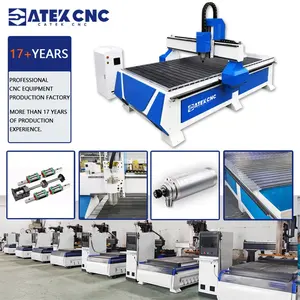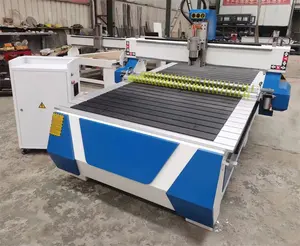
All categories
Featured selections
Trade Assurance
Buyer Central
Help Center
Get the app
Become a supplier

(5969 products available)

























A used 4-axis CNC router offers great capabilities for milling objects with complex geometries. Below are some types of 4-axis CNC routers:
Standard 4-Axis CNC Router
It features a rotating axis (A) in addition to the three standard Cartesian axes (X, Y, Z). The added rotational axis allows the machine to achieve complex cuts and increase productivity by reducing the need to reposition workpieces manually.
8-Axis CNC Router
This router is capable of moving in eight different directions. This machine typically has two additional rotary A and B axes. The 8-axis router is best for highly complex tasks like sculpting and hollowing. An 8-axis CNC machine can perform several jobs in one setup, thereby reducing processing time and increasing work efficiency.
Inline CNC Fluting Machine
It is designed specifically for machining flutes and other ornamental details onto cylindrical architectural substrates like wood columns and PVC pipes. It comes with an advanced 3D CAD/CAM software that makes it possible to create precision flutes with varying spacing and dimensions.
Portal 4-Axis CNC Router
Featuring a bridge-style structure, this CNC router has a fixed top frame and two vertical side components that form a hollow rectangle. It can be used to hold large and heavy workpieces while providing high accuracy and stability during the machining process. The portal 4-axis CNC router is also perfect for machining materials like metal, wood, and plastic.
4-Axis CNC Rotary Table
The rotary table adds rotational motion to a fixed setup. It consists of a circular plate mounted with a rotatable axis. The table allows for additional machining operations like engraving, milling, and drilling on circular and cylindrical workpieces such as jigs and fixtures.
Used 4-axis CNC Routers' specifications differ depending on the router's model and manufacturer. Here are some standard specifications for a 4-axis used CNC router;
Maintaining the 4-axis CNC routeriscriticalfor its durability and overall performance. Below are some maintenance tips to help the router stay in excellent working condition.
A 4-axis CNC router is a versatile machine that can be used in different applications in various industries due to its four-axis control functionality. Here are some common usage scenarios of a 4-axis CNC router:
Sign Making and Engraving
One of the common applications of a 4-axis CNC router is engraving personalized or custom signs and doing professional or commercial sign making. The machine can give a simple sign board with high-quality cuts or carving an upscale design an intricate shape. A 4-axis CNC router can also be used to create or engrave decorative letters, phrases, or designs on different materials like metal, wood, and acrylic.
Industrial Manufacturing
A 4-axis CNC router is commonly used in industrial manufacturing and machining. The machine is used to create and engrave apertures, holes, and contours with a high level of precision on different workpieces. This includes those made of stone or metal. A 4-axis CNC router can also be used to create assemblies, fixtures, and precision components including those for manufacturing industries like the electronic, automotive, and aerospace industries.
3D Design and Modelling
Four-axis CNC routers can be used to work on designs and models with three dimensions. The scenario involves the machine to rout, carve, or cut, creating parts and figures with three-dimensional shapes. A 4-axis CNC router can also be used for the creation of prototypes and architectural models. The device can rout or cut out models for product validation or design presentation, as well as prototypes for different engineering firms.
Architectural Details and Millwork
An A-axis CNC router can be used in carpentry as well as architectural work to create elaborate details, including intricate moldings, cornices, and rosettes, among others. The device works with high precision, allowing excellent and beautiful complex patterns or designs to be carved on wood, plastic, and composite materials.
Furniture Design and Interior Decoration
A 4-axis CNC router can be used to do or work on decorative and architectural elements like railing, columns, and partitions, which are made of wood or other composite materials. The device carves or cuts with an excellent level of precision, allowing for customization. As a result, the 4-axis CNC router is very useful for crowning or base molding routines.
Buying a used 4-axis CNC router for sale can be a great way to save some money. Still, there are some important things to check before parting with one's cash. First, check the reason for selling the machine. If the previous owner was happy with the performance of the machine, they would not be selling it. A good reason to sell an axis CNC router could be the relocation of their business to another industry where the machine may no longer be useful. Another reliable reason could be an upgrade to a more recent model.
Next, check the current performance of the machine to see how well it works in its present state. Assume that all used machines have some level of existing damage. New wear parts may need to be replaced, such as bearings and belts, to help the router function better.
It would help to gather as much information as possible about the machine from the seller. Ask any questions that may come to mind before closing the deal. For example, the age and hourly use of the router, if any upgrades have been made, and if it has ever been crashed or damaged.
It would also help to visit the machine before buying it. This gives a good idea of the working condition and allows for a physical inspection. It also gives the buyer a chance to test the machine and see if it actually meets their needs and requirements.
Try to see at least three other models before making a buying decision to help conclude the options available. Compare features, specifications, and prices. Research the cost of similar models to negotiate a better price and understand the market.
Finally, a warranty is essential, even if it is a limited warranty. This will offer protection against unexpected repairs shortly after the purchase. Consider any available warranty and support services offered by the seller to know what is covered and what is not when the machine breaks down.
Q: What materials can a 4-axis CNC router work with?
A: 4-axis CNC routers typically handle diverse materials, counting wood, foam, plastic, acrylonitrile butadiene styrene, aluminum, brass, and copper. Nonetheless, it is crucial to evaluate the machine's specifications and capabilities before anything.
Q: What is the maximum thickness of material that a 4-axis CNC router can process?
A: Maximum material thickness depends on the size and configuration of the CNC router. Generally, those with a thicker cutter can process thicker materials. When investing in a used CNC router, consider the maximum thickness for the intended application.
Q: Can a 4-axis CNC router machine metal?
A: While 4-axis CNC routers are primarily designed to work with softer materials like wood and plastic, some models can handle light metal machining. Nonetheless, only use a router meant for metal to avoid damaging it or compromising safety.
Q: What is the software used to program a 4-axis CNC router?
A: 4-axis CNC routers are usually programmed using CAD/CAM software. Such types of software allow users to create designs and translate them into machine-readable codes. Some popular examples of CAM software are Mastercam, ArtCAM, and SolidWorks.